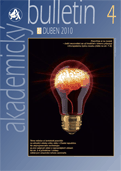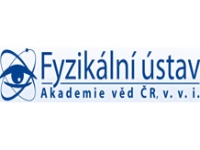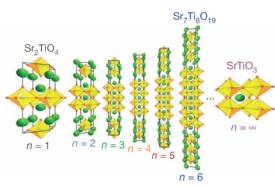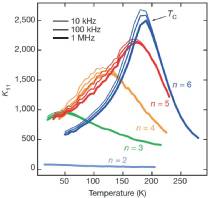Scientists from Institute of Physics ASCR contributed to development of a new approach to preparation of highly tunable microwave dielectrics exploring Srn+1TinO3n+1 with layered perovskite crystal structure. This material has in the form of 50 nm thin films and under mechanical strain excellent dielectric properties, which are promising for applications in microwave electronics, e.g. in cellular phones. The paper, describing unique properties and preparation of biaxially strained thin films of Srn+1TinO3n+1, was published in Nature journal on 16th October 2013.
Modern microwave filters and resonators used in cellular phones are made from materials, whose
permittivity
1 is tuned by electric field. Ferroelectrics
2 reach highest tunability near temperature of the phase transition from paraelectric to
ferroelectric phase, because the permittivity is the highest at this temperature. Nowadays, mainly
Ba
1‑xSr
xTiO
3 is commercially used, because it exhibits high tuning of permittivity. Unfortunatelly,
this material has undesirable high dielectric losses. Scientists from Department of Dielectrics
with American colleagues theoretically predicted, physically prepared and experimentally
characterized layered perovskite system Sr
n
+1Ti
n
O
3
n+1 with
n=1-6. Although this system is non-ferroelectric in the bulk crystals or ceramics, their
thin films become ferroelectric under tensile strain and their critical temperatures (T
c) increase with
n. Owing to this their permittivity and tunability increase. The best properties were
obtained in Sr
7Ti
6O
19, where high tunability and exceptionally low dielectric losses were observed. Sr
7Ti
6O
19 has one order of magnitude better microwave properties than widely used Ba
1‑xSr
xTiO
3. Dielectric losses are usually caused by structural defects, which are always present
in the materials. Authors found out that unique layered nanostructure of Sr
n
+1Ti
n
O
3
n+1 „absorbs“ defects and therefore it exhibits low dielectric losses.
Figure of layered crystal structure of Sr
n
+1Ti
n
O
3
n+1 with
n=1-6, ∞ and temperature dependence of dielectric permittivity in thin films of Sr
n
+1Ti
n
O
3
n+1. Temperatures of permittivity maxima correspond to paraelectric-ferroelectric
phase transition temperatures.
C.-H. Lee, N.D. Orloff, T. Birol, Y. Zhu,
V. Goian, E. Rocas, R. Haislmaier, E. Vlahos, J.A. Mundy, L.F. Kourkoutis, Y. Nie, M.D.
Biegalski, J. Zhang, M. Bernhagen, N. A. Benedek, Y. Kim, J.D. Brock, R. Uecker, X.X. Xi, V.
Gopalan,
D. Nuzhnyy, S. Kamba, D.A. Muller, I. Takeuchi, J.C. Booth, C.J. Fennie & D.G. Schlom,
Exploiting dimensionality and defect mitigation to create tunable microwave dielectrics, Nature
(2013),
http://dx.doi.org/10.1038/nature12582
This paper is result of a long-term collaboration between Institute of Physics ASCR and
Cornell University in USA. Authors from Institute of Physics ASCR are marked in bold.
More information can be obtained from Dr. Stanislav Kamba,
kamba@fzu.cz, phone: 266052957
1 Permittivity is material constant expressing capability of electrical polarizability
of the given material.
2 Ferroelectrics are spontaneously polarized materials whose polarization is switchable
under external electric field.
21 Oct 2013










